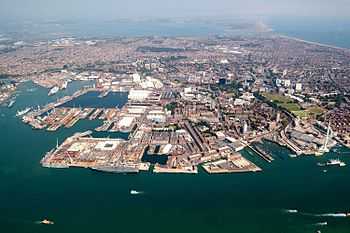HMNB Portsmouth
| HMNB Portsmouth | |
|---|---|
| Pompey | |
|
Portsmouth, Hampshire, England | |
|
An aerial photograph of Portsmouth Dockyard, which was taken as part of a photographic exercise from 2,000 feet. | |
| Type | Military base |
| Site information | |
| Controlled by | Royal Navy |
| Site history | |
| In use | 15th century–present |
| Garrison information | |
| Current commander | Commodore Jeremy Rigby (since October 2012). |
| Garrison | Portsmouth Flotilla |
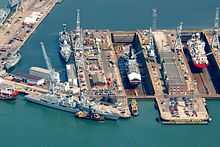
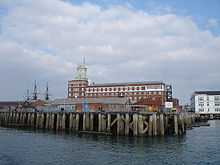
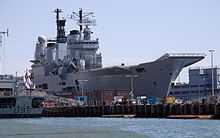
_is_anchored_in_the_English_Channel_as_a_ferry_prepares_to_transport_Sailors_to_Portsmouth_Harbor.jpg)
Her Majesty's Naval Base, Portsmouth (HMNB Portsmouth) is one of three operating bases in the United Kingdom for the British Royal Navy, (the others being HMNB Clyde and HMNB Devonport). Portsmouth Naval Base is part of the city of Portsmouth; it is located on the eastern shore of Portsmouth Harbour, north of the Solent and the Isle of Wight.
The base is home to one of the oldest dry docks in the world (the oldest and second-oldest are in Greenock on the River Clyde), as well as being the headquarters for two-thirds of the Royal Navy's surface fleet. The base is also home to a number of commercial shore activities, including shipbuilding and ship repair (operated by BAE Systems Maritime); naval logistics, accommodation and messing; and personnel support functions (e.g. medical and dental; education; pastoral and welfare) provided by Defence Equipment and Support.
The base is the oldest in the Royal Navy and it has been an important part of the Senior Service's history and the defence of the British Isles for centuries. At one time it was the largest industrial site in the world.[1] The Naval Base is also home to the "Portsmouth Historic Dockyard", which allows members of the public to visit important maritime attractions such as Mary Rose, HMS Victory and HMS Warrior.
The base commander since October 2012 is Commodore Jeremy Rigby.
The harbour is under the control of the Queen's Harbour Master, currently Commander Nigel Hare, who is the regulatory authority of the Dockyard Port of Portsmouth, an area of approximately 50 square miles (130 km2) that encompasses Portsmouth Harbour and the Eastern Solent. Shipping movements are handled by a team of admiralty pilots headed by the Chief Admiralty Pilot, Anthony Bannister.
Portsmouth naval base is home to two-thirds of the Royal Navy's surface ships, and employs up to 17,200 people. In addition, Portsmouth is building part of, and will be the home port of the two new Royal Navy aircraft carriers ordered in 2008, HMS Queen Elizabeth and HMS Prince of Wales, they will require that the harbour is dredged.[2] This project has secured the base's future for the next forty years and will revitalise shipbuilding in the city.[3] However due to budget cuts in 2013 shipbuilding in the Portsmouth was closed in favour of BAE keeping open its yards in Glasgow. It has been speculated this was to help retain Scotland in the union and it has been suggested by the BAE chairman that shipbuilding could return to the city if Scotland voted for independence[4]
Functioning base
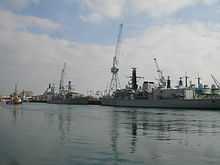
The base plays host to a large part of the surface fleet of the Royal Navy including the Type 45 destroyers, the majority of the Type 23 frigates, the River class fishery protection vessels and a squadron of mine counter-measures vessels (minesweepers and minehunters). The new Queen Elizabeth class aircraft carriers will eventually be based in Portsmouth, requiring that dredging be carried out to accommodate their considerable draft. Most of the vessels based in Portsmouth form part of the Portsmouth Flotilla, under the Fleet First reorganisation which saw the three (Portsmouth, Devonport and Faslane) port flotillas replace the frigate and destroyer squadrons and other groupings.
In total some 17,300 people work in the base. Until 2012 the Second Sea Lord as Commander-in-Chief Naval Home Command flew his flag from HMS Victory, which is the oldest commissioned warship in the world (although she was originally built at Chatham Dockyard). Since then, the post of Commander-in-Chief (and with it the use of Victory as flagship) has reverted to the First Sea Lord. (The Second Sea Lord is now at Henry Leach Building on Whale Island, which is also the headquarters of the Fleet Commander.)
Portsmouth Historic Dockyard
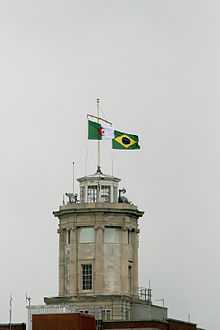
In addition to HMS Victory, a portion of the base serves as a maritime museum (now called "Portsmouth Historic Dockyard") and plays host to:
- The raised wreck of the Tudor carrack Mary Rose viewable from 2013 in a new Mary Rose Museum building
- HMS Warrior (1860)
- HMS M33, a World War I monitor
- The National Museum of the Royal Navy Portsmouth, one of the world's leading maritime museums
- Action Stations, a centre containing interactive exhibits demonstrating various aspects of naval science as well as a number of simulators
- Portsmouth Harbour Tours
- The Trafalgar Sail – the foretop sail of Victory used at the Battle of Trafalgar (1805)
History
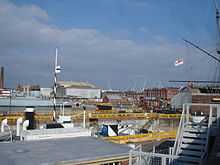
Along with Chatham, Woolwich, Plymouth and Deptford, Portsmouth has been one of the main dockyards for the Royal Navy throughout its history.
Tudors
The oldest dry docks in the world were built by Henry VII in 1495. The first warship built here was the Sweepstake of 1497; of more significance were the carracks Mary Rose of 1509 and Peter Pomegranate of 1510—both were rebuilt here in 1536. The wreck of the Mary Rose (which capsized in 1545, but was raised in 1982), is on display in a purpose built museum. A fourth Tudor warship was the galleass Jennett, built in 1539 and enlarged as a galleon in 1558; no new naval vessels were built here until 1648, but ships from Portsmouth were a key part of the fleet that drove off the Spanish Armada in 1588.
Seventeenth century
Naval shipbuilding at Portsmouth recommenced under the English Commonwealth; the first ship being the eponymous Fourth-rate frigate Portsmouth launched in 1650. In 1689, Parliament ordered one new dry dock and two new wet docks (or non-tidal basins) to be built at Portsmouth, work began in 1691 around the area of what is now No. 1 Basin. It was built to new designs developed by the naval engineer Edmund Dummer, surveyor to the Navy Board. He substituted brick and stone for wood and increased the number of altars or steps. The stepped sides allowed shorter timbers to be used for shoring and made it much easier for shipwrights to reach the underside of vessels needing repair. As with all extensions, the new works were built on reclaimed land, the civil engineering involved was on an unprecedented scale. The great stone dock, as it was called (extensively rebuilt in 1769 as No.5 dock) was evacuated with chain pumps powered by horses. A building slip was constructed where the Mary Rose is now in No. 3 dock.[5]
Napoleonic Wars
During this period, Portsmouth (like the other dockyards), underwent reforms proposed by Sir Samuel Bentham, Inspector-General of Naval Works. Among his innovations were Portsmouth Block Mills, an early example of truly industrial scale production.
Horatio Nelson, embarking on HMS Victory, left Britain from Portsmouth for the final time before his death at the Battle of Trafalgar.
Victorian era
HMS Warrior, the first ocean-going Ironclad built at Blackwall on the River Thames in 1860, is moored in the dockyard.
20th century
In 1900 the Third class cruiser HMS Pandora was launched, followed by the armoured cruisers Kent in 1901 and Suffolk in 1903. Two battleships of the pre-Dreadnought King Edward VII Class were launched in 1904—Britannia and New Zealand. The first modern battleship Dreadnought, was built in 1905–06, taking one day more than a year. Further dreadnoughts followed—Bellerophon in 1907, St. Vincent in 1908, Orion in 1910, King George V in 1911, Iron Duke in 1912 and Queen Elizabeth in 1913.
First World War
The largest vessel launched at Portsmouth during WWI was the 27,500-ton battleship Royal Sovereign in 1915. The only other launchings during the war were the submarines J1 and J2 in 1915, and K1, K2 and K5 in 1916. The Belfast-built M33, a monitor, has been on display at Portsmouth since 1999 after being refurbished at Hartlepool.
Inter-war years
The majority of warships launched at Portsmouth following the end of the War were cruisers—Effingham in 1921, Suffolk in 1926, London in 1927, Dorsetshire in 1929, Neptune in 1933, and Amphion and Aurora in 1934. There were also four destroyers—Comet and her sister Crusader in 1931, and the flotilla leaders Duncan in 1932 and Exmouth in 1934. The only other vessels launched between the wars were the mining tenders Nightingale in 1931 and Skylark in 1932.
Second World War
The destroyer flotillas (the capital ships having been evacuated to Scapa Flow), were essential to the defence of the English Channel, particularly during Operation Dynamo (the Dunkirk evacuation) and against any potential German Invasion. The base itself served a major refit and repair role. The Germans realised this importance and the city and base in particular was heavily bombed.
Portsmouth and the Naval Base itself were the headquarters and main departure point for the military and naval units destined for Sword Beach on the Normandy coast as a part of Operation Overlord and the D-Day landings on 6 June 1944. Troops destined for each of the landing beaches left from Portsmouth aboard vessels such as the armed merchant cruisers HMCS Prince Henry and HMCS Prince David, escorted by the Canadian destroyers HMCS Algonquin and Sioux. The majority of the naval support for the operation left from Portsmouth, including the Mulberry Harbours.
Post Second World War
Falklands Task Force
In 1982 Argentina invaded the Falkland Islands. In response a task force of British military and merchant ships was dispatched from Portsmouth Naval Base to the islands in the South Atlantic to reclaim them for the United Kingdom.
The task force consisted of the following ships:
- Two aircraft carriers
- Two landing ship docks
- Eight destroyers
- 15 frigates
- Three patrol ships
- Five submarines
- Three survey vessels
- Five minesweepers
- 10 fleet tankers
- Six logistic landing ships
- Five supply ships
- One helicopter supply ship
- 18 merchant ships including troop/cruise ships such as RMS Queen Elizabeth 2 and SS Canberra
Following some losses, the majority of these ships returned to Portsmouth later that year.
Trafalgar 200
In the summer of 2005 Portsmouth Naval Base and the Solent played host to two special events organised as part of the Trafalgar 200 commemorations recognising the 200th Anniversary of the Battle of Trafalgar. These were the International Fleet Review and the International Festival of the Sea.
Naval Establishments in the Portsmouth area
- HMS Nelson: HM Naval Base Portsmouth, encompassing both the dockyard and the Naval Personnel Centre on Queen Street.
- HMS Excellent: Whale Island, Portsmouth. Including the HQ of Fleet Commander; the Second Sea Lord (2SL); Naval Training facilities operated by Babcock International. All catering, front of house, cleaning and hotel services are sub-contracted to Compass Group plc.
- HMS Temeraire: Portsmouth. Training of Naval Physical Training Instructors and sports grounds and facilities for Portsmouth based personnel.
- HMS Collingwood: Fareham. Naval training provided mainly under contract to Babcock International. Catering and cleaning services are sub-contracted to Sodexo.
- HMS Sultan: Gosport. Naval (and tri-service) training, home of the centre of excellence for mechanical and electrical engineering. Naval training provided mainly under contract to Babcock International. Catering and cleaning services are sub-contracted to Sodexo.
Decommissioned
- HMS Dryad: Now MOD Southwick Park—Tri-Service Defence Police College
- HMS Dolphin diesel electric submarine base—Now MOD Fort Blockhouse
- HMS Vernon—Now in civilian use as Gunwharf Quays
- HMS Daedalus Fleet Air Arm base
- Royal Naval Hospital, Haslar
- Eastney Barracks (Royal Marine Artillery)—Now the Royal Marines Museum
- Forton Barracks (Royal Marine Light Infantry)—Now in civilian use as St Vincent College
- Royal Clarence Victualling Yard
- RNAD Gosport (including Priddy's Hard-Now Explosion! Museum of Naval Firepower)
- Haslar Gunboat Yard (opened 1859, closed 1973)
- HMS Mercury, East Meon, near Portsmouth
Portsmouth Flotilla
Ship of the Line
Type 45 Destroyers
Type 23 Frigates
Hunt class mine countermeasures vessels
- HMS Ledbury
- HMS Cattistock
- HMS Brocklesby
- HMS Middleton
- HMS Chiddingfold
- HMS Atherstone
- HMS Hurworth
- HMS Quorn
River class patrol vessels
- HMS Clyde - currently in the Falklands as guard ship since 2007
- HMS Tyne
- HMS Severn
- HMS Mersey
Antarctic Patrol Ships
- HMS Endurance— replaced in 2011 by MV Polarbjorn, renamed as HMS Protector (A173)
- HMS Protector (ex-MV Polarbjorn) - will be moved to HMNB Devonport in 2015
Archer class patrol vessels
References
- ↑ Abroad again in Britain, BBC
- ↑ "Drilling rig starts Portsmouth aircraft carriers work". BBC News. 13 February 2012.
- ↑ Portsmouth News, 6 July 2007.
- ↑ "Shipbuilding could return to Portsmouth, says BAE Systems chairman". 8 July 2014. Retrieved 14 December 2014.
- ↑ "History 1690–1840". www.portsmouthdockyard.org.uk. Retrieved 7 October 2009.
Further reading
- Stephen Courtney, Brian Patterson, Home of the Fleet: A Century of Portsmouth Royal Dockyard in Photographs (Sutton Publishing, 2005) ISBN 0-7509-2285-0.
- James Goss, Portsmouth-built warships 1497–1967 (Published by Kenneth Mason, 1984)
- C. I. Hamilton, Portsmouth Dockyard Papers, 1852–1869: From Wood to Steel, a calendar (Winchester, 2005).
- R.J.B. Knight, Portsmouth Dockyard Papers, 1774–1783: the American War: a calendar (Winchester, 1987)
External links
| Wikimedia Commons has media related to HMNB Portsmouth. |
- HMNB Portsmouth web page
- Portsmouth Royal Dockyard Historical Trust website
- Portsmouth Historic Dockyard website
- Portsmouth D-Day Museum
- Queen's Harbour Master, Portsmouth
